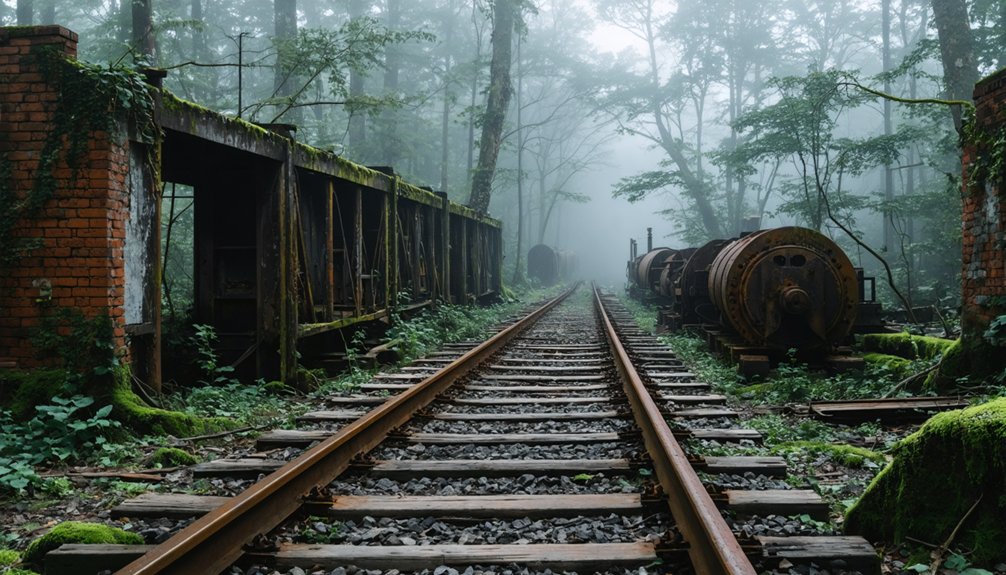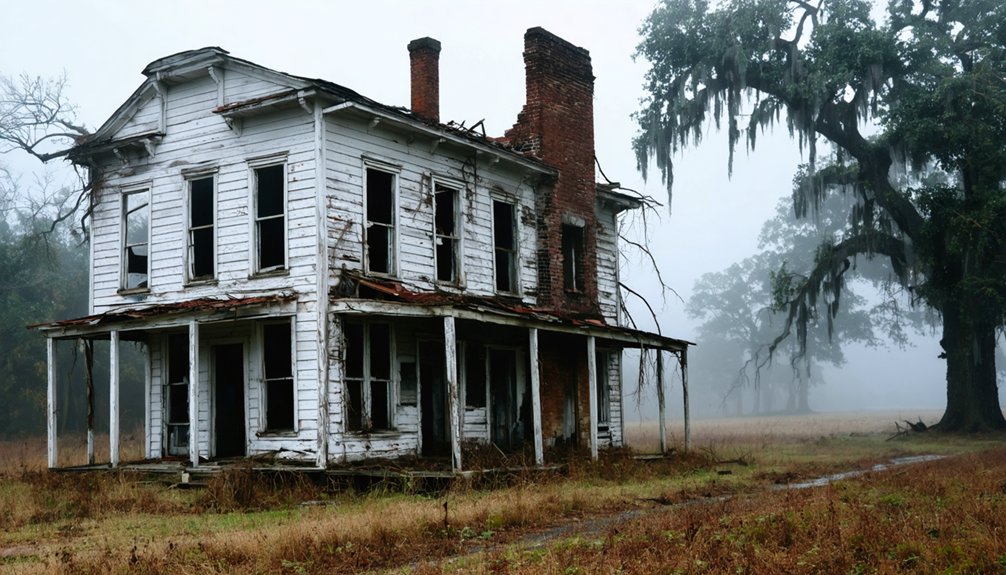You’ll find Livingston’s haunting remains in Floyd County, Georgia, where it emerged as an agricultural settlement in the early 1800s. The town flourished around its post office, established in 1834 and named after Representative Leonidas F. Livingston. Cotton production drove its economy until the 1920s boll weevil infestation contributed to its decline. Today, only scattered stone foundations, a cemetery with weathered headstones, and a decaying Baptist church mark this once-vibrant community’s mysterious past.
Key Takeaways
- Livingston was an agricultural settlement in Floyd County, Georgia that emerged in the 1800s and later became abandoned.
- The community’s post office, established in 1834, operated for over 60 years before closing during the town’s decline.
- Cotton farming’s collapse due to boll weevil infestation in the 1920s contributed significantly to Livingston’s abandonment.
- Only a cemetery, historic marker, scattered stone foundations, and a decaying Baptist church remain from the original town.
- Local legends include reports of supernatural activity, with visitors claiming to witness ghostly figures and mysterious lights.
Origins and Early Settlement History
While many Georgia ghost towns boomed and busted due to mining or industry, Livingston emerged as a modest agricultural settlement in Floyd County during the early 1800s.
You’ll find it followed typical settlement patterns of northwest Georgia’s rural development, establishing itself as an unincorporated community at coordinates 34°12′46″N and 85°20′55″W.
The community’s identity took shape around its post office, established in 1834 and named after Leonidas F. Livingston, a U.S. Representative from Georgia.
Unlike more dramatic ghost towns that rose rapidly and fell just as quickly, Livingston maintained a steady presence for over six decades through its post office operations. Similar to Bartow, which saw its population plunge from 582 in 1920 to under 200 today, Livingston experienced a gradual decline.
Livingston defied the typical ghost town trajectory, sustaining itself quietly for decades through its humble post office service.
The community never developed major infrastructure or experienced significant growth, instead serving primarily as a small agricultural and postal hub for local residents. Like Livingston Place in Florida, which began as The Cedars plantation, the area’s agricultural roots ran deep.
Life in Early Livingston
Life in early Livingston reflected the complex social dynamics of antebellum Georgia, where cotton plantation owners, smallholders, and enslaved people formed distinct social strata.
You’d find community dynamics centered around compact townships, designed for defense and social control, where settlers participated in militia training and fortification building. The Spanish missions established nearby between 1568-1684 influenced early settlement patterns.
The town’s social interactions were shaped by strict trustee regulations, while The Cedars plantation, established by General William Bailey, dominated the local economy. Each male settler received 300 pounds of meat and other essential provisions annually to sustain their families.
You’d see smallholders working marginal lands alongside large cotton operations dependent on enslaved labor. Daily life involved clearing land, building homes, and maintaining uneasy relations with local Creek tribes through trade and treaties.
Religious life, particularly among German Lutheran settlers, provided another layer to the community’s social fabric.
Economic Rise and Development
Cotton production at Livingston Place fueled the early development of local trade networks in the 1820s, as the Bailey family’s plantation shipped its harvests to broader markets.
You’ll find that the plantation’s success enabled the growth of supporting industries like gristmills and sawmills, though these remained relatively small-scale compared to neighboring Georgia towns.
Like the ghost town of Auraria, Livingston’s economic prosperity was closely tied to a single industry that would eventually lead to its downfall.
While agricultural activity centered primarily on cotton throughout the 19th century, the plantation’s economic influence shaped the region’s development until attempts at diversification in the 1920s. The devastating impact of the boll weevil infestation ultimately contributed to the town’s decline and eventual abandonment.
Early Trade Networks Emerge
As Georgia’s colonial economy took shape, indigenous trade networks laid the foundation for complex commercial relationships between Native American tribes and European settlers.
Similar to the vital roles played by the Mandan and Hidatsa tribes in establishing major trading centers elsewhere, ancient trade routes like the Sand Hill Path had already established essential corridors for indigenous commerce, connecting settlements along rivers and through the interior.
When European traders arrived, they quickly tapped into these existing networks. The Savannah River became a bustling artery of commerce, with trading posts like Fort Moore facilitating exchanges of deerskins, furs, and gold. Deerskin exports through Charleston saw dramatic growth, reaching 355,207 pounds by 1758.
By 1735, Augusta emerged as a significant trading hub where merchants like John Rae and Patrick Brown operated successful trading companies.
The Colonial Trading Path, adapting earlier Native American routes, connected the Creek Nation to English posts at Ocmulgee Old Fields, cementing Georgia’s position in the colonial economy.
Agricultural Growth Spurs Development
Building upon the established trade networks, Livingston’s agricultural sector emerged as a powerful economic force in the early 1800s. You’ll find cotton cultivation at the heart of this transformation, with Livingston Place leading the way in 1819. Local farmers later adopted satellite-based solutions to optimize their crop management and yields.
The region’s cotton production expanded dramatically, reaching its peak in the early 1900s when Georgia harvested over 5 million acres. A group of Macon, Georgia businessmen purchased the property in 1919 and continued the tradition of cotton farming under the new name Georgia-Florida Farm.
Agricultural innovation became essential as challenges emerged. When the boll weevil struck in 1915 and post-WWI prices plummeted, you’d have seen farmers diversifying into livestock, poultry, and vegetables.
The change wasn’t easy – especially for sharecroppers and tenant farmers who often found themselves trapped in cycles of debt. Despite these hurdles, the agricultural evolution shaped Livingston’s development, laying the groundwork for a more diverse economic future.
Local Industries Take Shape
The arrival of the Northern Pacific Railroad in 1882 transformed Livingston into a bustling industrial hub, marking the region’s shift from purely agricultural roots.
You’ll find that industrial diversification quickly took hold as railroad shops opened in 1883, creating jobs and supporting local businesses throughout the area.
The mining impacts were substantial, with coal and gold extraction operations flourishing alongside new coke production facilities, especially after the 1887 rail spur to Cokedale was established.
You can trace how the timber industry emerged simultaneously, taking advantage of the region’s forests and new rail transportation networks.
These combined industries created a robust economic ecosystem, with blacksmiths and metalworkers serving the mining sector while timber operations supplied both local construction and export markets.
The Path to Abandonment
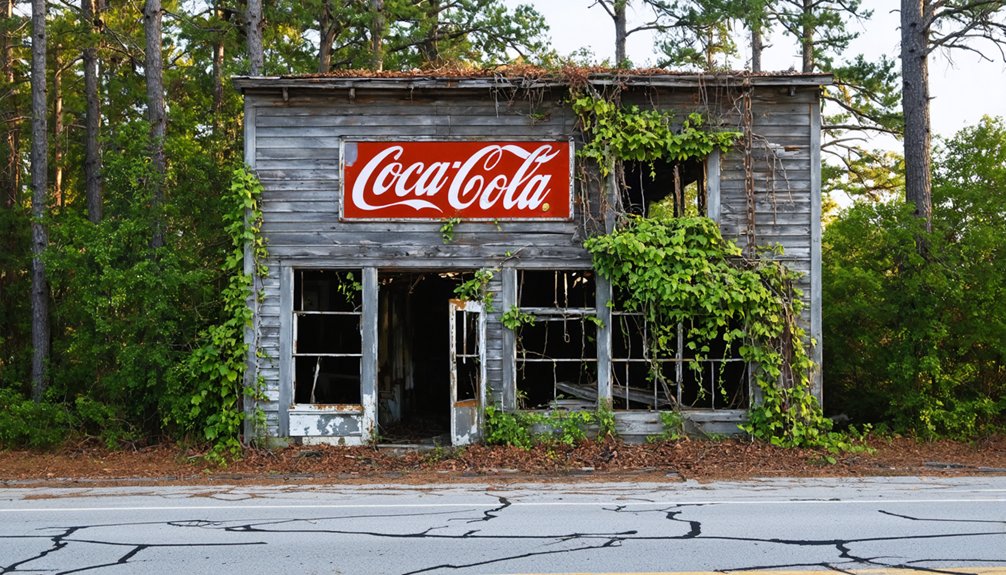
While Livingston once thrived as a bustling agricultural hub in southwest Georgia, its downward spiral began shortly after Albany’s establishment in 1836.
You’ll find that community migration toward the growing town of Albany steadily drained Livingston’s population, while economic shifts diminished its commercial importance. The town’s heavy reliance on cotton-based industries left it vulnerable when regional trade patterns changed.
As businesses shuttered one by one – from the cotton gin factory to the general store – the town’s infrastructure crumbled.
The closure of essential services like the post office and school marked the community’s final decline.
Today, you’ll discover little evidence of Livingston’s former vitality beyond a cemetery on private land, scattered grave markers, and a historic roadside marker commemorating its existence.
Surviving Structures and Ruins
If you’re exploring Livingston today, you’ll find scattered stone foundations marking where homes and businesses once stood throughout the former town site.
The most prominent surviving remnants are centered around the old cemetery grounds, where weathered headstones and deteriorating burial plots chronicle the community’s past residents.
A primitive Baptist church structure, though heavily decayed, still stands nearby as one of the few remaining vertical structures, its architectural elements reflecting the town’s religious heritage.
Remaining Stone Foundations
Stone foundations scattered across Livingston’s ghost town landscape provide essential archaeological evidence of its former structures and layout.
You’ll find stone wall remnants marking the perimeters of what were once thriving agricultural and industrial buildings. These industrial relics tell the story of early settlement life and commerce.
Key foundation remnants you can still explore include:
- Partially collapsed stone-lined wells near former homestead sites
- Chimney bases and scattered foundation stones from commercial buildings
- Stone embankments and retaining walls along old roadbeds
- Mill foundation remnants with underground masonry supports
The site’s stone ruins, though fragmentary and often obscured by vegetation, provide valuable insights into Livingston’s original architectural footprint and community infrastructure.
Cemetery and Church Remnants
Despite years of neglect, Livingston’s historic cemetery and church ruins stand as poignant reminders of the town’s once-vibrant community.
You’ll find various types of graves, including brick vaults and stack stone burials, though natural erosion and vandalism have taken their toll. The church’s architectural remnants reveal the craftsmanship of an earlier era when it served as the spiritual center of town life.
Local preservation efforts focus on documenting the cemetery’s historical markers before they’re lost to time. These gravesites offer valuable insights into the community’s past, with headstone inscriptions providing essential genealogical information.
While limited resources challenge grave preservation initiatives, the cemetery and church ruins remain critical links to Livingston’s heritage, telling stories of the families who once called this place home.
Notable Historical Figures and Families
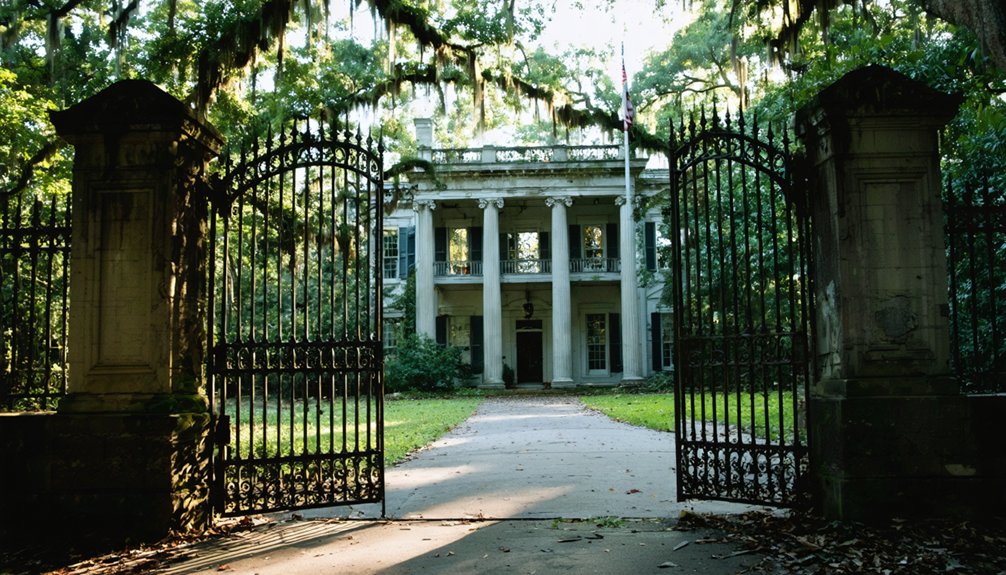
Historical records reveal little about the specific individuals and families who once called Livingston home.
Like many rural Georgia settlements of its era, the community was likely shaped by local leaders who managed affairs through informal gatherings rather than official town councils.
The settlement’s social fabric was characterized by:
- Subsistence farming families working small land plots
- Church elders and informal community organizers serving as decision makers
- Founding families whose names have been lost to time
- Small landowners practicing communal agriculture
You’ll find no evidence of prominent industrialists, state politicians, or nationally recognized figures emerging from Livingston.
Instead, the community appears to have been typical of rural Southern settlements, where leadership rested with everyday citizens managing their shared institutions and agricultural pursuits.
Local Legends and Stories
Tales of supernatural occurrences have permeated Livingston’s abandoned streets since its decline, with numerous visitors reporting unexplained phenomena throughout the ghost town‘s remains.
You’ll find haunted legends spanning generations, from accounts of ghostly miners who perished in cave-ins to stories of a vengeful healer who allegedly cursed the town. Local folklore suggests the land itself holds supernatural energy, intensifying during storms and fog.
If you’re exploring these ruins, you might encounter the ghostly sightings that have made Livingston infamous: shadowy figures in empty doorways, mysterious lights dancing through vacant windows, and inexplicable cold spots within deteriorating buildings.
Visitors regularly report poltergeist activity, with objects moving mysteriously and unexplained knocking sounds echoing through the abandoned structures.
Legacy and Historical Significance
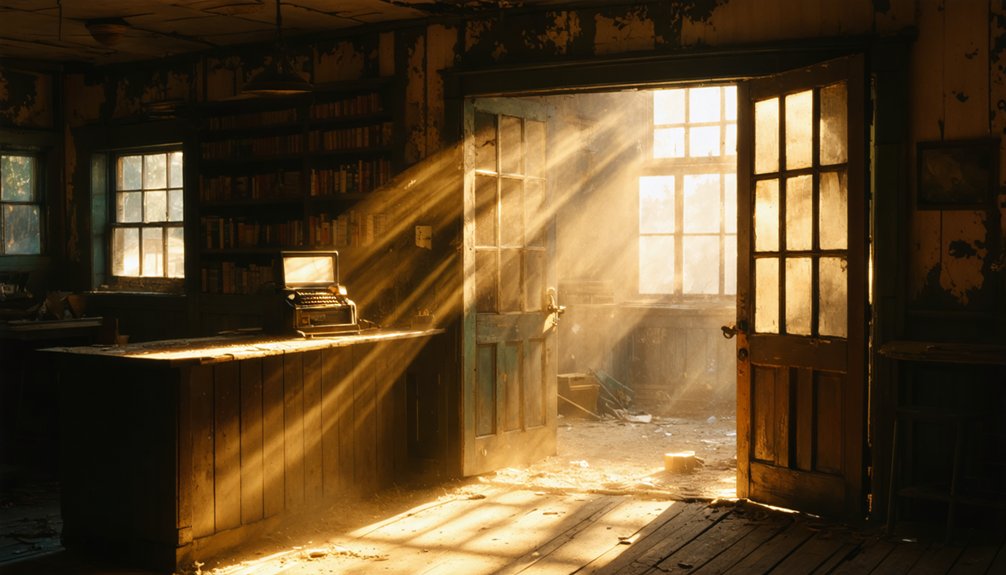
As a cornerstone of Georgia’s agricultural heritage, Livingston Place evolved from its humble beginnings as The Cedars plantation in 1819 to become a significant symbol of the American South’s evolution.
You’ll find its legacy preserved through four key contributions:
- The property’s Neo-Classical Revival main house, built between 1938-1940, stands as the last personal residence designed by renowned architect Mr. Pope.
- Its role in hosting the Continental Field Trial since 1937 demonstrates enduring sporting traditions.
- The historic gardens, designed by Robert Ludlow Fowler Jr., showcase cultural heritage through landscape architecture.
- The recent shift to Tall Timbers management guarantees both historical preservation and scientific advancement.
The site’s journey from cotton plantation to conservation center reflects the evolving story of the American South, bridging past and future through thoughtful stewardship.
Ghost Town Tourism and Preservation
While Livingston Place’s architectural legacy endures through preservation, today’s ghost town faces mounting challenges in tourism and conservation.
You’ll find the site grappling with nationwide tourism declines that have impacted many historical destinations across America. Local preservation efforts rely heavily on community involvement and limited state funding to maintain the town’s authentic character.
Despite economic challenges, you can support ghost town tourism through guided educational tours that bring Livingston’s history to life.
The town’s preservation teams are leveraging digital promotions and social media to attract visitors seeking unique historical experiences. However, they’re battling infrastructure needs and environmental factors that threaten site accessibility.
Frequently Asked Questions
Are There Any Paranormal Activities Reported in Livingston’s Remaining Structures?
You’ll find ghost sightings in abandoned structures, including apparitions, unexplained scratches, and eerie sounds. Several haunted locations feature shadowy figures, with both malevolent and benevolent spirits reported by witnesses.
What Items of Value Have Been Discovered by Metal Detectorists?
You’ll find pocket watches, dress weights, miners’ lanterns, and tax tokens while metal detecting. Treasure hunting here reveals coins, glass bottles, industrial tools, and personal trinkets from the town’s mining era.
Can Visitors Legally Explore and Photograph the Ghost Town Site?
You’ll need explicit permission from property owners before exploring, as Livingston Place isn’t actually a ghost town but private property. Photography permissions must be obtained, and ghost town regulations don’t apply here.
Which Movies or Television Shows Have Filmed Scenes in Livingston?
You won’t find documented film locations or television productions shot in Livingston. While nearby Georgia towns have hosted major productions, there’s no verified evidence of any shows filming in this area.
Are There Any Annual Events or Commemorations Held at the Site?
You won’t find any annual festivals or historical reenactments at this forgotten site. Despite countless ghost towns hosting regular commemorations across America, there’s no evidence of organized events happening here.
References
- https://www.youtube.com/watch?v=7HCxA37uVDg
- https://wheninromega.com/mountain-springs-church/
- https://943litefm.com/abandoned-ghost-towns-new-york/
- https://en.wikipedia.org/wiki/List_of_ghost_towns_in_Georgia_(U.S._state)
- https://www.ezhomesearch.com/blog/ghost-towns-in-georgia/
- https://theforgottensouth.com/powelton-methodist-church-georgia/
- https://freepages.rootsweb.com/~gtusa/history/usa/ga.htm
- https://www.youtube.com/watch?v=OfhPAHTOkJE
- https://talltimbers.org/livingston-place/history/
- https://en.wikipedia.org/wiki/Livingston


